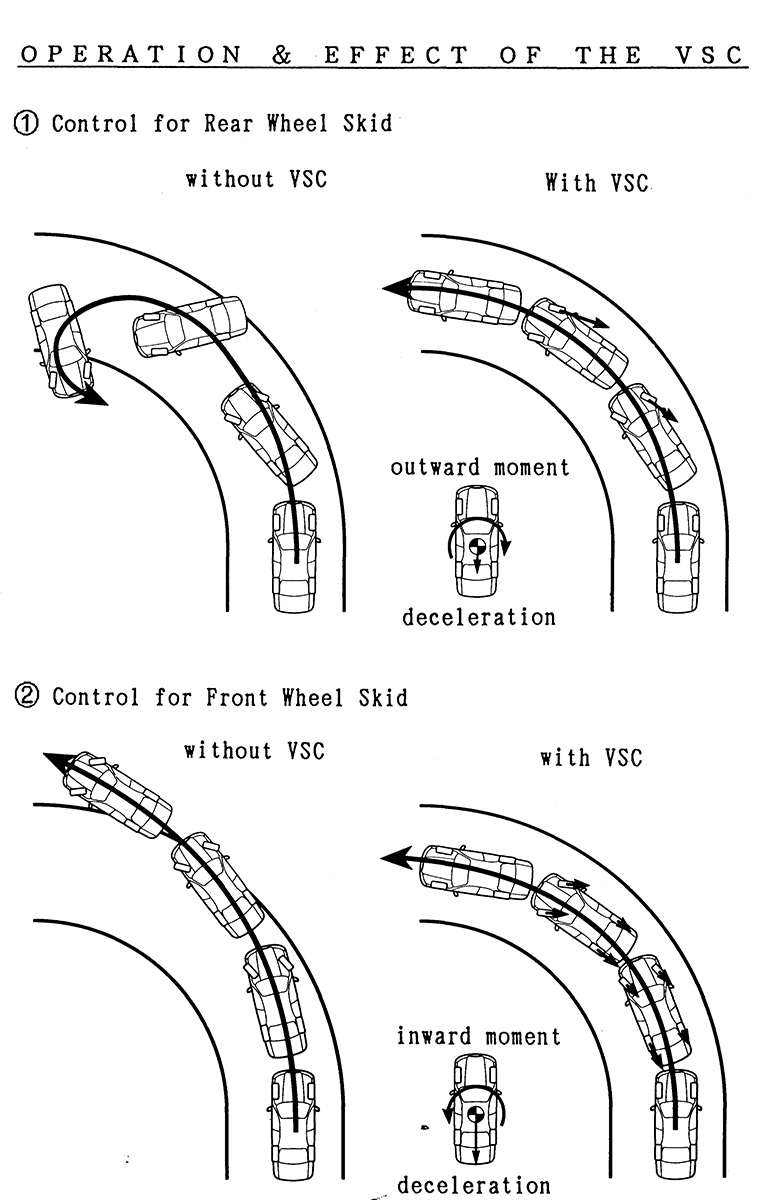Apr. 26, 1995
Toyota Announces Car Safety Equipment Plan
Develops New Preventive Safety Technology
Tokyo―TOYOTA MOTOR CORPORATION announced today that it has embarked on a safety equipment improvement plan for all passenger cars and recreational vehicles (RVs) it sells in Japan, and has developed the Vehicle Stability Control (VSC) system, a new, advanced preventive safety system.
Assurance of motor vehicle safety has always been a top-priority for Toyota, and it has long been committed to research and development of new active and passive safety technologies as well as the dissemination of safety equipment.
To further increase passive safety, the price of optional supplemental restraint system (SRS) air bags for all passenger vehicles and RVs has been reduced. At the same time, SRS air bags and four-wheel antilock brake systems (ABS) will be installed as standard equipment at the earliest possible date. Moreover, marketing of individually-sold driver-side SRS air bags will start for certain models which were originally bought without the optional driver-side SRS air bag.
VSC is an advanced preventive safety system that reduces wheel skidding caused by sudden steering movements or abrupt changes in road conditions, and hence helps prevents accidents.
Models equipped with VSC are scheduled for introduction this fall.
Safety Equipment Improvement Plan for All Passenger Cars and RVs
SRS Air Bags*1- Introduction of driver-side air bags as standard equipment and increased availability of passenger-side air bags
- The following will be offered for all passenger cars and RVs
-
- Driver-side air bags will be installed as standard equipment by the fall of 1996;
- Passenger-side air bags will be installed as standard or optional equipment by the spring of 1997.
- Reduction of option priceThe price of SRS air bags available as options for some models will be reduced from May of this year.
- The price of driver-side air bags will be reduced from ¥50,000 or ¥100,000 to ¥25,000 or ¥40,000, respectively.
- The price of passenger-side air bags will be reduced from ¥100,000 to ¥40,000.
- Marketing of individually-sold SRS driver-side air bags
- Individually-sold air bags, currently installable on 17 models,*2 are scheduled for introduction this May.
- Manufacturer's suggested retail price of ¥50,000 or ¥70,000.
Four-wheel ABS*3- Broader standard equipment installationThe ABS system will be made standard equipment for 60% of all passenger cars and RVs, by the end of 1996 and increased installation will be encouraged.
- Introduction of driver-side air bags as standard equipment and increased availability of passenger-side air bags
New Vehicle Stability Control (VSC) System to Prevent Skidding
The new VSC system is designed to prevent lateral skid not controllable by the average driver through active control of brakes and engine output, such as where the driver steers abruptly to avoid obstacles, or when turning on slippery road surfaces.ABS and traction control (TRC) systems have been commercialized to control vehicle skid caused by inappropriate braking and accelerating. VSC is effective in controlling skid caused by sudden steering and road surface changes. It is an innovative system that covers a wider range of motor vehicle instability which is not possible with existing preventive safety equipment.Skidding when TurningIt is necessary for the vehicle to change direction, matching the steering angle maneuvered by the driver. In sudden turns, however, the gap between the steering angle and vehicle direction widens, causing skidding.VSC MechanismWhen the VSC detects vehicle skid, braking on the outward wheel of the vehicle adds rotational power in the opposite direction to the skidding. Also, the vehicle is decelerated by controlling the brake and engine output which reduces skidding and assures vehicle stability.In a skid situation, to turn to the left, instantaneous braking on the vehicle's front right wheel will add rotational power to the right and reduce counter-clockwise skidding of the car (Diagram 1).If the driver fails to corner on a curve and the car skids toward the outside of the curve, braking power is applied on each wheel and engine output is reduced. Tire grip is regained by deceleration, and steering along the course becomes possible (Diagram 2) .Installation ScheduleAs Toyota views this equipment as a system that achieves more advanced preventive safety, it plans to introduce VSC on a vehicle this fall.
- *Notes
-
- SRS air bagCollision safety equipment to supplement the seat belt, designed to minimize injury to the passenger in a severe head-on collision.
- Models where installableVista, Camry, Corona, Carina, Celica, Curren, MR2, Caldina, Corolla, Sprinter, Sprinter Carib, Tercel, Corsa, Corolla II, Cynos, RAV4 L, and RAV4 J.
- Four-wheel ABSA system designed to enhance automobile safety, maneuverability, and accident avoidance by preventing the wheels from locking when the vehicle is overbraked so as to retain directional stability even under emergency braking on a slippery road surface.





